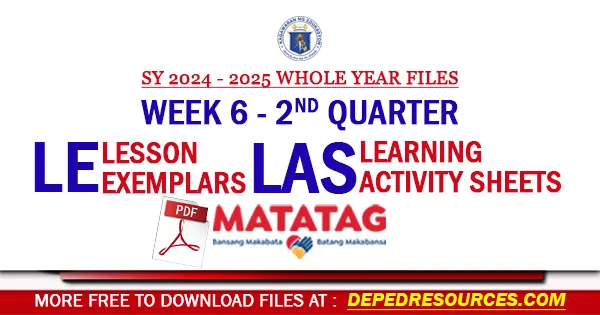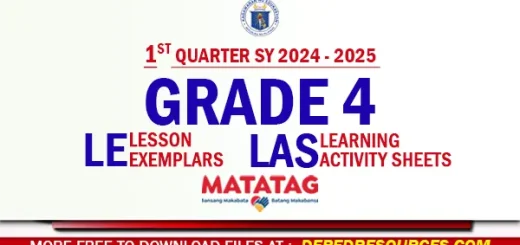Week 6 2nd Quarter Lesson Exemplars (LE) Learning Activity Sheets (LAS) SY 2024 – 2025
What are Lesson Exemplars (LE)?
Lesson exemplars serve as structured guides that assist teachers in developing impactful and engaging lessons. These models outline essential components of a lesson such as objectives, materials, activities, assessments and reflection offering a cohesive framework for lesson planning. They are especially beneficial for new or less experienced teachers providing consistency and standardization across teaching practices.
A typical lesson exemplar includes several core elements. Objectives are the specific goals that students should achieve by the lesson’s end, guiding the purpose of the instruction. Materials and Resources provide a comprehensive list of tools, supplies and technology required for the lesson ensuring that teachers are well-prepared. Activities and Procedures detail the steps to deliver the lesson, often including interactive activities that enhance student engagement and understanding. Assessment strategies are also included to evaluate student learning and track progress. Differentiation strategies offer approaches to accommodate diverse learning styles and needs ensuring that all students can benefit. Lastly, Reflection encourages teachers to evaluate the lesson’s effectiveness and consider areas for improvement.
Using lesson exemplars aligns lessons with curriculum goals aiding students in comprehending challenging subjects like mathematics. Effective math instruction requires not only subject knowledge but also an understanding of students’ learning processes and perspectives on math. Lesson exemplars help teachers simplify complex ideas into clear, manageable steps enhancing student understanding.
Additionally, lesson exemplars foster collaboration among teachers allowing them to share and refine strategies that address varied student needs and close learning gaps. When culturally relevant, these exemplars create a more inclusive learning experience fostering critical thinking and problem-solving skills. Overall, lesson exemplars support teachers in creating a structured, engaging and adaptable learning environment for students.
What are Learning Activity Sheets (LAS)?
Learning Activity Sheets (LAS) are essential educational resources designed to enhance classroom engagement and reinforce key lessons. These worksheets feature exercises, activities and assessments that allow students to practice independently helping teachers gauge understanding while keeping students actively involved.
Each LAS typically includes several core elements. They start with Introductory Concepts, which provide background information and an outline of the upcoming activities. The Activities section may include various tasks from writing exercises to creative tasks like drawing or hands-on activities, each aimed at engaging different senses to foster deeper learning. Rubrics for Scoring help students understand the evaluation criteria for their performance, while Answer Keys provide correct responses for self-assessment. Lastly, References offer additional resources for further exploration of the topic.
LAS are versatile and adaptable for different subjects and grade levels making them useful for both in-person and remote learning environments. In subjects like math and science, LAS encourage active engagement by making lessons interactive. They help students develop critical skills including fluency, flexibility and creative thinking especially when incorporating cognitive strategies that support deeper learning.
The design of LAS is often influenced by constructivist teaching approaches where students build knowledge through personal experiences. This student-centered approach changes the teacher’s role from merely providing information to facilitating the learning process, promoting greater student involvement and responsibility for their own learning.
While LAS are effective tools, they do have limitations. Students learn at varying paces, so a single worksheet might not suit everyone’s needs. To address this, teachers can differentiate LAS to accommodate diverse skill levels. Moreover, in remote learning contexts, maintaining motivation and ensuring access to technology can be challenging. Offering offline versions of LAS and including interactive elements can help overcome these obstacles. When thoughtfully designed, LAS not only support learning but also encourage students’ creativity and engagement in the learning process.
















